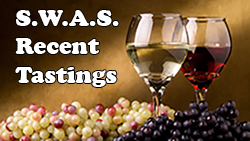Saturday 6th November 2021: "English, Sweet & Fortified" - with Elizabeth & Christopher in Worthing
A special Tasting this evening and Elizabeth & Christopher's first SWAS hosting at their home in Worthing. Christopher's extensive Cellar was raided for this evening's wines which he & Elizabeth very generously shared with an extremely lucky eleven of our members whilst Dinner was served! The wines were suberb including at least two rated by Robert Parker 97/100 and above!

The Menu (Supper prepared and served by Elizabeth):
Starter: Chicory, Blue Cheese & Pear
Main Course: Beef and Venison Casserole served with Potato & Celeriac Mash, Parsnips, Broccoli & Carrots
Dessert: Lemon Tart followed by Cheese

The English:
1.  2014 King's Cuvée; Hattingly Valley, Alresford, Hampshire; 45% Pinot Noir, 43% Chardonnay, 12% Pinot Meunier; 12% abv.
2014 King's Cuvée; Hattingly Valley, Alresford, Hampshire; 45% Pinot Noir, 43% Chardonnay, 12% Pinot Meunier; 12% abv.

A very limited release, the Kings Cuvée is a premium blend of Chardonnay, Pinot Noir and Pinot Meunier. 100% barrel fermented and then aged for seven months in old oak barrels, resulting in a much softer, creamier and spicier wine. (The producers) were spoilt for choice when it came to selecting the absolute best barrels for this prestige wine, thanks to the exceptional 2014 vintage. Once bottled, the wine aged for fifty-two months on lees allowing the development of its complex toasty character. A small dosage of 4g/L was added after disgorgement to balance the wine’s bright acidity.
2.  2018 Chardonnay; Danbury Ridge Vineyard, Danbury, Essex; 14% abv
2018 Chardonnay; Danbury Ridge Vineyard, Danbury, Essex; 14% abv
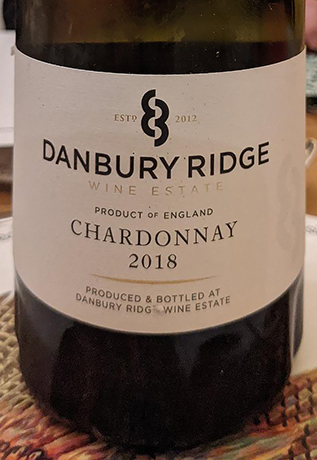
Danbury Ridge have wowed the critics with their inaugral still wine releases. This is their first Chardonnay, from the fabulous 2018 vintage: it is elegantly perfumed and fresh with citrus flavours of lime zest and mandarin with white peach. This palate displays mouth-watering acidity with a delightful texture and great length.
Fruit was handpicked and whole bunch pressed. After little or no settling the juice was transferred to 228L Burgundian oak barrels for fermentation. The wine was then left on gross lees for 10 months, where malolactic fermentation took place without battonage. The wine received another 10 months elevage before release without any fining.
Danbury Ridge was founded by two generations of the Bunker family: Michael and Heather Bunker and their daughters, Janine and Sophie. The first vines were planted in 2014, with an unwavering focus on still Pinot Noir and Chardonnay clones to exploit the unique mesoclimate. After just a few seasons the vines were producing grapes of a ripeness previously unseen in the UK.
Estaurine Essex is smeared with a thick layer of London Clay, but at Danbury Ridge this tenacious deposit lies beneath a significant overburden of fluvial-glacial sand and gravel. It is this coarse aggregate, deep in some places, shallow in others, that makes Danbury Ridge so special. The Danbury Ridge mesoclimate comes into its own in late summer. Ripening does not stall with the autumn equinox. Natural woodland shelter belts, together with the light topsoils, magnify the effects of September sunlight.
3.  2018 Pinot Noir; Danbury Ridge Vineyard, Danbury, Essex; 14% abv
2018 Pinot Noir; Danbury Ridge Vineyard, Danbury, Essex; 14% abv
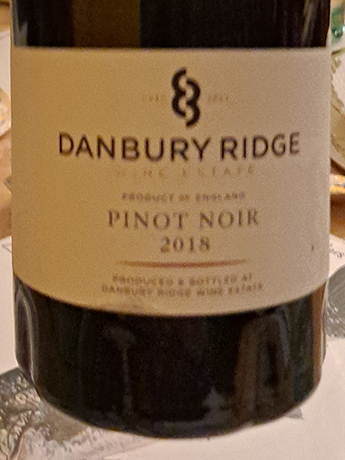
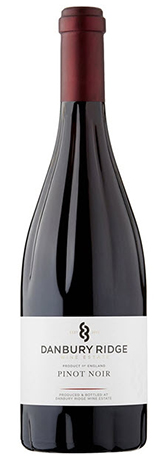
VINTAGE NOTES The 2018 vintage was an excellent growing season. The intense cold and heavy snowfall brought on by the “Beast from the East” delayed the growing season and crucially meant frost at bud-burst was avoided. The warm temperatures and dry conditions prevailed into summer and our vineyards’ experienced 1,039 growing degree days. This long vegetative cycle allowed for slower grape maturation, enhancing flavour development. Near perfect conditions at harvest has resulted in wines that exhibit elegant textures and a generous fruit profile making 2018 a vintage of an exceptional nature that will allow for cellaring.
THE VINEYARD The Octagon Block is the most established vineyard on the estate with an eclectic soil profile. Spanning over 12 acres, most of the vines sit on glaciofluvial sediments of sandy gravel, known as Danbury Gravel, that accumulated during the last Ice Age, and clay outcrops at the lower, southern end. Clay is renowned for producing powerful wines and gravel pulls in the opposite direction. Planted at low density, the Octagon Block has proven itself capable of producing Chardonnay and Pinot Noir that are exceptionally rich and complex.
VINIFICATION The fruit was handpicked and sorted in the vineyard and winery. Grapes received 100% destemming but no crushing to maintain whole berries. Using gravity the grapes were transferred to open-top fermenters for cold soak. Temperatures were allowed to increase naturally, but kept very cool for fermentation. After fermentation, wine was transferred to barrels for MLF, battonage and 12 months ageing. The wine was bottled unfined and unfiltered. TECHNICAL INFORMATION Barrel aged: 100% French oak for 12 months pH: 3.53 TA: 5.1 g/L Alcohol: 13.5%
TASTING NOTE Showcasing notes of black cherry mixed with aromas of plum and mint. Hints of wood spices and cedar add complexity to the aromatics. Black fruits dominate the palate with silky smooth tannins and a fresh acidity that leaves a lasting impression on the finish.
RELEASE DATE: Autumn 2021 • BOTTLES PRODUCED: 3351

The Sweet:
4.  1947 Chateau d'Yquem, Sauternes; 1er Cru Classé Supérieur
1947 Chateau d'Yquem, Sauternes; 1er Cru Classé Supérieur
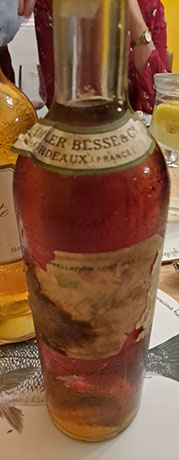

Robert PARKER - The Wine Advocate (02-2017) 97/100 -
"Tasted almost exactly a year after my previous encounter, this 1947 Château d'Yquem replicated the performance back then. It revealed that burnished amber color, then the glorious, intense and rich bouquet with dried honey, quince and mandarin, that hint of red fruit in the background tracing the birth year back to this hot postwar summer. The palate unctuous, almost heavy in the mouth, the acidity retaining sufficient freshness and poise with a powerful, quite spicy finish that feels extraordinarily long in the mouth. To repeat my earlier sentiment, whilst the 1947 is not up there with the greatest Yquem such as the 1929, 1945 or 2001, it occupies the tier below...and that's good enough for me."
5.  1990 Chateau Gilette, Sauternes;
1990 Chateau Gilette, Sauternes;



The Fortified:
6.  1955 Amontillado Solera Sherry , Perez Barquero
1955 Amontillado Solera Sherry , Perez Barquero
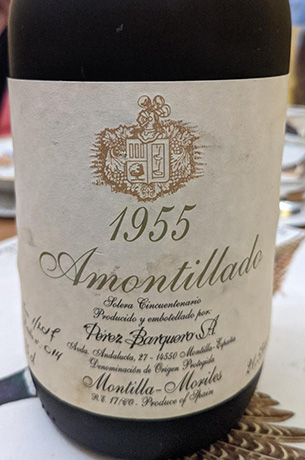
Bodegas Pérez Barquero were founded in 1905. Since 1985 it is part of a group owned by Rafael Cordoba, which also includes the wineries Bodegas Gracia, Vinicola del Sur and Tomas Garcia (most of them producing classic wines).
Pérez Barquero owns 100 hectares of vineyards, located between the Guadalquivir, Guadajoz and Genil rivers, including some of the best plots in the area (Sierra de Montilla and Moriles Alto) on pure albariza soils. Like most of the producers in Montilla-Moriles they focus on Pedro Ximénez grapes, also for the dry wines. On top of their own vineyards they control 400 hectares of partner grape growers.
More than half a century of art The Amontillado from the solera commemorating the fiftieth anniversary of the founding of the Winery is an exceptional example of the winery wisdom that defines Montilla-Moriles and specifically to Pérez Barquero.
Timeless elegance, complexity, intense expression and a world of memories in which the salty airs bring the aroma of a long and living history. Ancient, meditation and pleasure wine, which we also recommend enjoying with specialties of marked flavor and strong contrast. A gift of time and nature.
7.  1998 Catine Pellegrino Ambra Marsala Superiore Riserva ; Sicily; Grillo/Catarrato/Inzolia blend ; dessert wine
1998 Catine Pellegrino Ambra Marsala Superiore Riserva ; Sicily; Grillo/Catarrato/Inzolia blend ; dessert wine
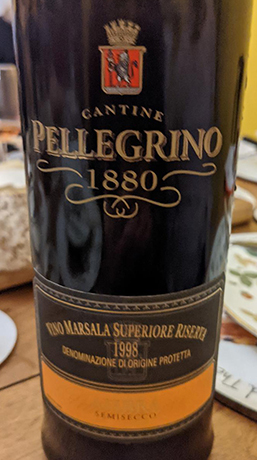
Cantine Pellegrino is one of Sicily's most important and prosperous wineries. Today they are one of very few families who can trace their lineage back to the original 19th Century founders of the Marsala trade.
Pellegrino are 1 of only 3 of all the original 19th Century Marsala trade founders to still be in existence. Incredibly out of these 3 they are 1 of only 2 that have kept the company in the family. Today they are unquestionably one of the leading Marsala producers.
Grape varieties: Grillo, Catarratto and Inzolia. An intense amber colour. Versatile and semi-dry, it has delightful notes of apricots with delicate scents of thyme and pepper. Excellent with all Sicilian pastries and ricotta and pastry creams.
8.  Vecchio Samperi, Marco de Bartoli, Marsala; Sicily;
Vecchio Samperi, Marco de Bartoli, Marsala; Sicily;
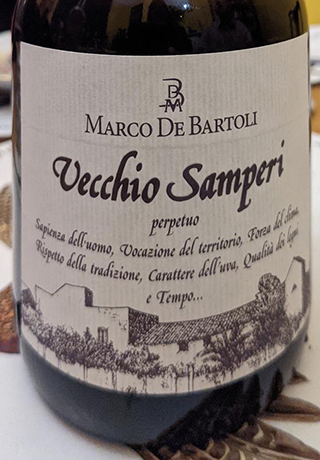
Marsala production dates back to the 1770's, when the Englishman John Woodhouse accidentally stumbled across the local wine made in a method called il perpetuum, basically a fortified wine. He immediately shipped it back to England, where it was successfully received. In the following decades more British-born merchants arrived, production increased, a harbor and nearby warehouse was built for ease of transport (based on the Oporto model) and most importantly the solera system was imported from Madeira and Sherry. This prosperity continued through the next century and beyond 1860, when the Italian states unified (Garibaldi landed his unifying army of exiles in the port of Marsala - the rest is history). At that point, an important business man named Vincenzo Florio started bottling Marsala independently and under his own name. The wine steadily rose in popularity over the years, and by the early 1900's there were a 100+ wineries in the city of Marsala, most located right on the coast for easy exporting.
By the 1960's, local wine cooperatives had grown considerably and production started focusing on quantity instead of quality. Instead of using the indigenous and traditional Grillo, co-ops started blending all types of white grapes indiscriminately. Furthermore, fortification, chaptalisation and the addition of caramel food coloring or cooked must to give the illusion of advanced oxidation became commonplace. Predictably, the increasingly poor quality of Marsala slowly killed off the reputation of what was once highly distinguished wine. Even today, many still consider Marsala little more than cheap cooking wine for the staple recipes of Italian-American restaurants.
Enter Marco de Bartoli. In his youth, Marco had worked with his father on his family farm near the town of Marsala. But his obsession with cars and a need for speed proved too strong, leading to a first career as a professional race car driver. Towards the end of this career, however, Marco was ready to turn a new leaf. Thinking back on his youth, he felt a deep sadness that the once proud tradition of Marsala had sunken so low. He decided he wanted to change this.
First, Marco reconstructed his family's old cellar on his mother's farm in the contras of Samperi. Then he searched high and wide for old solera barrels of Grillo from local contadini. Much to his surprise, many were eager to part with these ancient relics, some even happy to give them to him for free! Next came the vines, planted progressively and exclusively in Grillo, which in Marco's eyes was and is THE ONLY grape to make Marsala due to its high acidity, ability to reach high degrees of alcohol and aging potential. Finally the wines: "Vecchio Samperi" represented the unfortified, traditional style of Marsala while the "Superiore" line was fortified with mistella (sweet must and eau de vie) as a statement that the cantina was not only rooted in the past, but well versed in the present and future.
In 1984, Marco started a new project on the island of Pantelleria, originally producing only a Passito. By the early 1990's, his had garnered a stellar reputation for being alone in making truly stunning expressions of Marsala terroir.
But the story doesn't end there. By the mid 1990's, Marco's children Renato, Sebastiano and Giusippina had all joined him in this work. Youthful energy led to new experiments, most notably dry white wines from Grillo and later Zibibbo from Pantelleria. While chemicals had never been used in the vineyards and the Grillo for the Marsala was never yeasted, conventional yeasts were used on the dry whites until 2006. Sebastiano elaborates on working organically and using native yeast fermentations:
"Our idea was always to make wine as a product of the land so we have always eschewed systemic chemicals. I do not remember a particular date we followed this course (organic), but I can tell you that about ten years ago I personally began to follow this campaign and have been sure of it ever since. I distinctly remember that even before then my father did not want to do intensive agriculture and prevented the farmer who worked our lands from using fertilizers, herbicides and so on...
Up to now we did not seek organic certification because it did not seem a serious approach and my father's point of view was never to have "organic" be a selling point for his work. But my dad was extreme and today organics seem to be a more serious issue. We understand the need for people to have the certification, so we are now seeking it.
For the indigenous yeasts, the key was the production of the "Integer" in 2006. I am not reneging the selected yeast used in the 90's because it allowed us to understand an innovative form of Grillo and Zibibbo. But with the experiments of the Integer we understood the potential of the land was far more important than so many other things, knowing also that it was more risky. It may not always be the same for the tastes and aromas of the wine, but it certainly enhances the territorial typicity."
9.  1875 Pereira D'Oliveira Malvasia Vintage Madeira ; Madeira; Malvasia Candida, 20% abv
1875 Pereira D'Oliveira Malvasia Vintage Madeira ; Madeira; Malvasia Candida, 20% abv
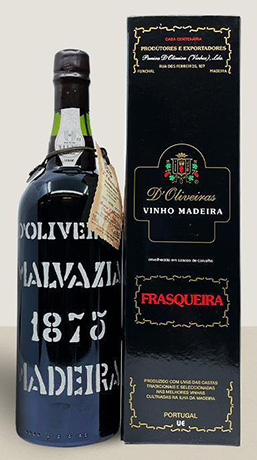
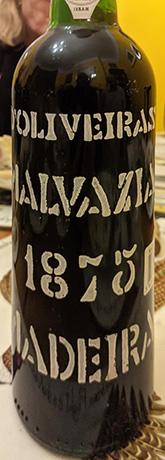
A wine of exceptional quality made only from the Malvasia grape variety, aged in cask under the traditional canteiro system for a minimum of 20 years and bottled only when it begins to display the degree of depth and complex charachteristic of full maturity. Vintage Madeira aka Garrafeira or Frasqueira are the epitome or excellence and the glory of Madeira.
Tasting Notes: With 171g of residual sugar, this is the oldest Malvasia from Pereira D'Oliveira still in cask. Lush, silky, rich and decadent, yet fresh and focused, this Malvazia has Incredible balance, vibrant acidity, and a multitude of flavours including caramel, ginger, dates, clove and honey, with a gorgeous finale that just persists with no apparent end.
10.  1955 Taylors Vintage Port;
1955 Taylors Vintage Port;
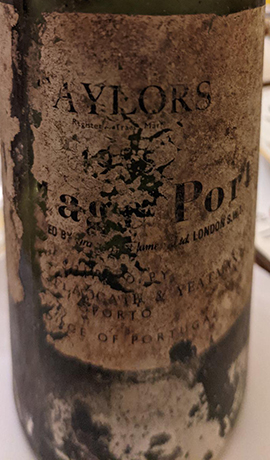
The only vintage Taylor’s declared in the 1950s. According to the Fladgate Partnership, ‘one of the most underrated vintages of the century’. Taylor’s own two great vineyards in the Douro, Quinta de Vargellas and Quinta de Terra Feita. Both are categorised grade A - the highest possible rating. In years when Taylor’s produces a classic vintage, wines from these two estates are blended together. As they are some 20 miles apart, and subject to very different micro climates, they combine to produce a powerful, long lived and complex vintage port.
In 1955 there was a heatwave at the end of April and early May. Rain at the end of May was beneficial for the flowering. July and August were hot, and at the time of the vintage the bunches were in excellent condition. The general starting date for the vintage was on the 26 September, and a shower on the 22 September did a lot of good. Light rain fell on 2 and 3 October but did no harm, and helped cool the temperature.
Mid rose red. This somehow not only looks but tastes rose red. Lovely and lifted and fresh. There's a real core of excitement to this. How lovely!
Rating: 19 Jancis Robinson MW OBE - www.JancisRobinson.com (Jul 2016) "An opage blockbuster when young, astringent and unready up until the early 1980's. In the early 1990's still fairly deep coloured; a vast, deep, high-toned, spicy nose, fairly sweet, full bodied packed with fruit extract and tannin and acidity.."
11.  2007 Hundred Acre 'Fortification' Port, Napa Valley, California; Cabernet Sauvignon; 18.5% abv
2007 Hundred Acre 'Fortification' Port, Napa Valley, California; Cabernet Sauvignon; 18.5% abv
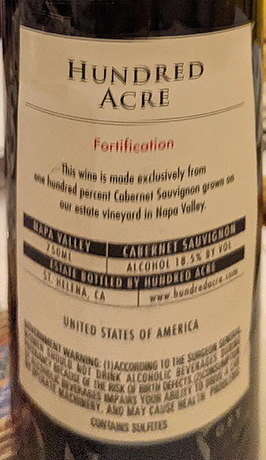
Robert PARKER - The Wine Advocate 100/100 -
Robert Parker's Wine Advocate: "Pale to medium tawny colored, the 2007 Fortification offers up rip-roaring coffee, Black Forest cake, caramel-coated walnuts and raisin cake scents with suggestions of sandalwood, Indian spices and a touch of dates. Full-bodied and full-on rich, unctuous and seductive, it has a plush frame and perfectly knit freshness, lifting the hedonic flavor layers to a very long, luxurious finish. One sip transports you to a whole other level of decadence!"


